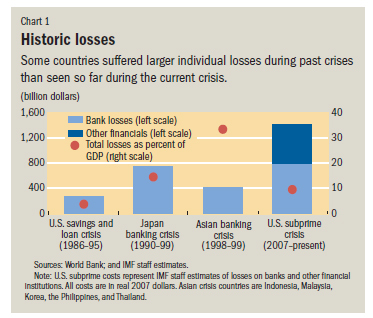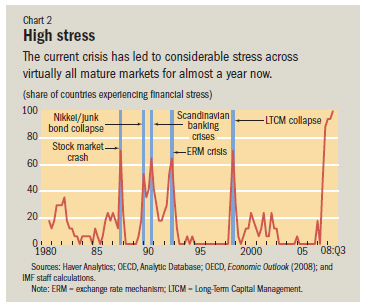The IMF has released its December 2008 Issue of Finance & Development. Articles are:
- Cracks in the System: Repairing th Damaged Global Economy
- F&D on Financial Crisis Origins
- Preventing Future Crises
- When Crises Collide
- A Crisis to Remember
- Global Financial Turmoil Tests Asia
- The Crisis through the Lens of History
- Ensuring Food Security
- Stockholm Solutions
- Neighborly Investments
- The Road to Recovery: A View from Japan
- Nigeria’s Shot at Redemption
- The Catch-Up Game
- The Economic Geography of Regional Integration
To be frank, I wasn’t much impressed by the Stockholm Solutions article about the Nordic crisis. It was very general.
A topic more suited to generality was The Crisis through the Lens of History:
A second important lesson is the value of providing macroeconomic support in parallel with financial actions. With the effectiveness of monetary policy limited by financial disruptions, fiscal stimulus must play an important role to help maintain the momentum of the real economy and curtail negative feedbacks between the financial and real sectors. Indeed, increasing interest is now being paid to boosting infrastructure spending, akin to the public work programs of the Depression era. But, as the Japanese example makes clear, macroeconomic support by itself provides only breathing room, not a cure; it is essential to use the space provided to address the underlying financial problems or the outcome will be a series of fiscal packages with diminishing impact. And it should also be recognized that there will be limited space for macroeconomic responses in countries where the weakness of public sector management has been an integral source of the problem, as has often been the case in emerging market crises.


Additionally, the article on Preventing Future Crises contains many of the familiar old nostrums but, as a saving grace, adds an element I’ve been harping on:
Safeguarding diversity to promote systemic complementarities
The degree to which financial institutions with long maturing liabilities (for example, pension funds and life insurance companies) should be subject to mark-to-market requirements or to risk management standards based on risk models focused on short-run price volatility in managing
their assets could be reconsidered. Regulations could increase the scope for such institutions to play the role of long-term, hold-to-maturity investors. But low-leverage financial institutions with limited systemic importance may need only light, if any, regulation, thus allowing them to play a potentially stabilizing role in taking more risky or contrarian positions compared with other market participants (Nugée and Persaud, 2006).
I’ve said it before … I’ll say it again. The current crisis has shown significant cracks in bank regulation, but let’s not throw the baby out with the bathwater. What we should be aiming for is a rock solid banking system core, surrounded in turn by more exciting investment banks, which are in turn surrounded by a wild-n-wooly world of hedge funds, SIVs, and whatever else gets dreamed up to make a buck.